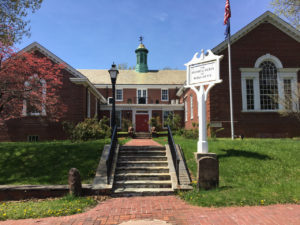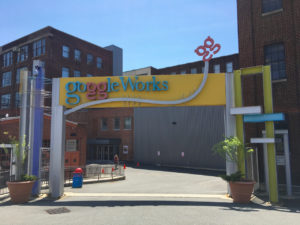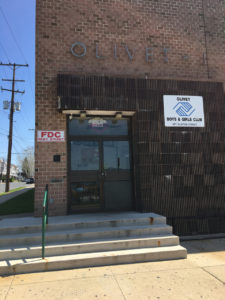The largest and most ubiquitous community organizations are related to the religious congregations situated within the Northwest Reading section (J. Slifko, personal communication, March 18, 2017; T. McMahon, personal communication, March 13, 2017). According to Father Garcia of St. Margaret’s Catholic Church, many informal groups, such as youth groups and charity groups, have been directly and indirectly operated by churches, while others utilize the church as a networking hub in order to mobilize the community. Garcia spoke of his church’s current efforts to have an official youth group, but they are having trouble, as most of the people interested in running it are adults. (A. Garcia, personal communication, March 13, 2017).
Similarly, former city mayor Tom McMahon states that City Council and the local city government are increasingly working with churches to mobilize various communities, as they are valuable resources in efforts to reach out to local residents (Personal communication, March 13, 2017).
Historically, a major institution in the neighborhood had been the Reading Railroad YMCA on 6th Street, which had been a staple of the community from 1896 until its closing in 1969, moving to Washington Street in downtown Reading. The former YMCA building is now the Hope Rescue Mission, a homeless shelter (Kelly, 2016).
Here are some notable examples of current formal institutions:
Berks History Center

The Berks History Center was founded in December 1869 when local Reading residents and community leaders saw a need to collect historical documents and objects for reminiscence and education. Meetings were held on 6th street outside of the neighborhood, and the Historical Society did not have a dedicated building until 1904 at 519 Court Street in downtown Reading. With all the objects and documents being collected by the Historical Society, they grew out of their building. Construction for a new Berks History Center building began in 1928 on Centre Ave, and was completed in October 1929, where the Center stands to this day. Requiring more space in 2008, the Historical Society purchased and renovated the former M&T bank building located directly behind the Center, turning it into the Henry Janssen Library (“About Us”, n.d.).
GoggleWorks Center for the Arts

The GoggleWorks is located in the building that was once Thomas A. Willson and Co., the world’s first manufacturing facility for optical glasses. The business became famous for patenting the process for creating shatterproof glass in 1876. Keeping with their reputation for having impeccable safety standards, T.A. Willson and Co. began making safety glasses, and through the 1900s, a variety of safety equipment, such as ear protectors and gas masks. By 1939, T.A. Willson and Co. became Willson Products, and was developing aviator goggles and oxygen masks for fighter pilots during World War II.
When the Occupational Safety and Health Act (OSHA) was passed in 1970, which required employers to provide safe working conditions for workers, Willson Products increased their manufacturing of safety eyewear products (Park, 2010). In 1989, Christian Dalloz bought the company. However, they closed in 2002, when the company restructured its industrial base to consolidate its worldwide production, with products in 75 countries.
Three years later, under the direction of local philanthropist Al Boscov, with the assistance of retired industrialist Marlin Miller and then-Mayor Tom McMahon, the GoggleWorks Center for the Arts opened in the former Willson Products building. GoggleWorks is a nonprofit facility that holds classes, exhibitions, and camps for adults and children of all ages involving art, music, glasswork, woodwork, and sculpting (“History”, n.d.).
GoggleWorks has been instrumental in generating tourism within the Northwest Reading neighborhood specifically, as it draws many visitors from outside the city to observe the exhibits and participate in workshops. Al Boscov also credited the GoggleWorks as the stepping stone that played a key role in the passage of other developments in the city, such as the R/C IMAX Theatre, the Doubletree Hilton, and later the GoggleWorks Apartments. Ellen Horan, former President of the Greater Reading Chamber of Commerce & Industry, stated during the building’s tenth anniversary celebration that it made Reading as a whole stand out amongst other cities in Pennsylvania, as, “The arena is a big attraction, but a lot of cities have arenas. Not many have a GoggleWorks” (Devlin, 2015).
In addition, GoggleWorks has also played a role in improving the reputation of the neighborhood, both within and abroad, as art centers in other cities such as Schuylkill Haven, PA and Alexandria, VA have looked to the GoggleWorks with interest (Devlin, 2015).
Olivet Boys & Girls Club

William “Mac” McCormack, an altruistic businessman who wanted to help working-class boys from Reading to become good citizens, founded the Olivet Boys and Girls Club in 1898. There were five Olivet Boys Clubs located around the City of Reading, which McCormack ran and financed until his death in 1923 at the age of 57 from pneumonia. The first, stand-alone club was built at the corner of Clinton and West Oley Streets in Northwest Reading in 1910 by McCormick, then editor of the Reading Herald Newspaper. The Clinton Street Club housed two bowling alleys, billiards, game, and meeting rooms, shower baths, a shooting gallery, and a gymnasium with a stage. Later, the club added an outdoor swimming pool, and Reading’s second playground, called Outdoor Fields. (Boulanger, 2016)
Today, McCormick’s vision carries on. The Olivet Club has seven locations in the city serving both boys and girls. In 1990, the name changed to Olivet Boys and Girls Club and girls were able to join the club as official members. (Yatron, 2016)The club’s primary goal is to provide the children of Reading with mental, physical, and social support. There are several programs offered within the clubs, which include technology programs, sports fitness and recreation, good character and citizenship, specialized initiatives, academic success, healthy lifestyles, and the arts. Each program provides children with different opportunities to indulge in their passions and foster creative thinking. The club also participates in many community initiatives and encourages their members to get involved. The club is used as a positive reinforcement for the youth and to keep them busy with productive options (“About Us”, n.d.).

